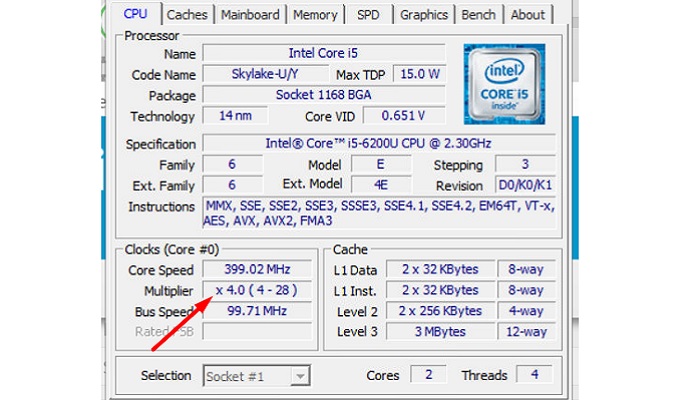In This Article
What is CPU Multiplier?
The CPU multiplier in a computer is the ratio of speed between the Central Processing Unit or CPU and the Front Side Bus or FSB. In simple terms, it indicates how fast the CPU will run with respect to the speed of the FSB.
Technically, this is the measure that helps to determine the internal frequency of a processor based on the frequency of the FSB. This is the actual bus frequency and not the effective frequency of the bus.
KEY TAKEAWAYS
- The ratio between the CPU and the FSB of a computer is known as the CPU multiplier.
- This measure tells how many internal cycles will the CPU see for every cycle of the external clock. The higher the multiplier, the better it is for the CPU.
- The newer CPUs usually come with a locked multiplier and therefore cannot be changed from the BIOS but the high-end CPUs usually come with unlocked multipliers.
- Increasing the clock ratio may increase the overall performance of the system, but there are some caveats.
Understanding CPU Multiplier

The CPU multiplier is the bus/core ratio of the computer. This metric is the comparison of the internal CPU clock rate and the external clock supplied.
A CPU multiplier is also known by different names such as:
- Clock ratio
- CPU core ratio
- clock multiplier or
- Simply as a multiplier.
For example, if a CPU has an operational speed of 2.66 GHz and its external clock speed is 133 MHz, its multiplier will be 20. This will have no unit because it is a ratio.
When you know the clock ratio, or the ratio of the CPU and FSB, you can determine how fast the CPU runs.
For example, if the CPU multiplier is known to be 10x, the CPU will run 10 times faster than the speed of the Front Side Bus.
This means that the CPU will see 10 internal cycles produced by the Phase Lock Loop or PLL-based frequency multiplier circuit, for each cycle of the external clock.
As said earlier, the bus frequency considered to find the CPU core ratio is the actual and not the effective bus frequency.
This actual bus frequency may be different for different types of processors.
This is because some processors may use Double Data Rate or DDR buses, such as the AMD Athlon and Duron processors, while others may use quad data rate buses, such as all Intel processors starting with the Pentium IV.
Ideally, for these processors, the effective bus rate should be divided by 2, in the case of AMD processors, and by 4, for Intel microprocessors.
The clock ratio of most of the modern microprocessors is fixed and, usually, you will not be able to change the clock multipliers of these processors.
Though that is not allowed, you may still overclock them with a different technique, which is by altering the other factor of the equation – the FSB frequency.
However, there are some high-end processor versions that come with ‘unlocked’ multipliers.
This means that you can overclock them by raising the clock multiplier setting in the BIOS setup program on the motherboard.
If the clock multiplier is locked, you can, however, underclock them to make them run at a lower frequency but surely cannot overclock them higher than what they are marked or intended to run at, according to the CPU design.

Is Higher CPU Multiplier Better?
Yes, the higher the multiplier, the better it is because the CPU will be able to complete a higher number of internal cycles in one external clock cycle.
This is very useful for CPU-intensive applications because the overall performance of the system will be higher.
You may even overclock a CPU for that matter from the BIOS, provided it comes with an unlocked multiplier.
Though not all computer motherboards will offer the option to adjust the multiplier through BIOS or the Basic Input Output System, you may do so with a few. Just look under the CPU or overclocking section.
However, when you do, you must keep in mind that there may be some potential issues due to overclocking the CPU.
Therefore, there are some caveats that are worth knowing with respect to overclocking a CPU that comes with an unlocked multiplier.
- First, the cooling system should be quite good because overclocking a CPU will result in greater heat production.
- On the other hand, when you increase the bus speed or the external clock, it may affect the CPU, the RAM, and other components of the computer.
- Most importantly, it should not create any bottleneck while fetching more data from the memory at a higher speed.
In short, careless overclocking may damage the CPU as well as the other parts of the computer due to voltage breakdown and also due to overheating.
How Do You Increase the CPU Multiplier?
You can increase the multiplier of an unlocked CPU from the Overclocking Settings menu in the BIOS settings. Remember, it may not be named Overclocking Settings in all BIOS sections for CPU settings.
It can also be called CPU Tweaker, CPU Management, or something similar.
The steps to follow are:
- Shut down your computer
- Restart it and press and hold down a specific button which can be F2, F8, F10, or Delete, to enter BIOS
- Go to Overclock Settings by using the arrow keys and return keys since your mouse will not work when the BIOS is open
- In this settings menu, use the down arrow key to go to CPU Ratio entry or something with a similar name
- Take note of the current setting and increase the multiplier by one only for the first time
- Save and exit BIOS.
The penultimate step is important. For example, if the clock speed of your CPU is 3.3 GHz and you see that the multiplier in the BIOS is set to 33, you should increase it to 34.
When you exit, the computer will restart and the operating system will be reloaded.
When it does, open an app you want to use and check how the system performs. If you find that it is becoming hot fast or it has shut down unexpectedly, go back to BIOS and lower the multiplier back to what it was before your attempt.
How Do You Lower the CPU Multiplier?
You can underclock the CPU by lowering the CPU multiplier, once again, in the BIOS settings of the motherboard.
The steps to follow are pretty much the same as those above, and are as follows:
- Shutdown and restart your computer, pressing the BIOS setup key
- When BIOS is launched, Go to the Advanced submenu
- Go to CPU Ratio or CPU multiplier or Clock Adjustment options in the menu
- Select the CPU Multiplier Clock option
- Change the value to the subsequent lower numbered option
- Save and exit BIOS.
What is an Unlocked Multiplier in a CPU?
As mentioned earlier, there are some processors that come with an unlocked multiplier which will allow you to overclock it by increasing the CPU multiplier.
This way, you can push the speed of the CPU beyond the factory settings in order to maximize its potential.
This will, however, not affect the clock speed of other components of the computer system.
CPU Multiplier Calculator
The CPU multiplier calculator typically multiplies the CPU ratio with the CPU Base Clock or BCLK to find the actual clock speed of the processor.
The calculator usually needs to use Javascript capable and enabled browsers to calculate the BIOS settings for the motherboards that allow overclocking.
The speed displayed by the calculator is usually in megahertz or gigahertz.
Conclusion
CPU multiplier is an important metric that tells the users about the performance of the CPU so that they can have a fair idea about how the overall system would perform.
Though most of the newer CPUs come with a locked or a fixed multiplier, some specific high-end versions do allow making adjustments.